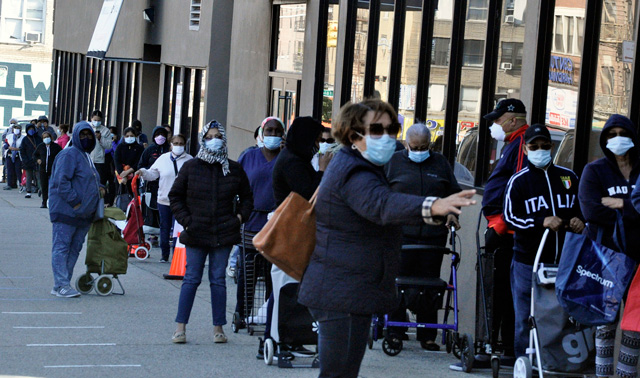Covid-19 Unemployment Spike in The Bronx

A line of NYC residents awaiting food distribution at the Washington Heights Ecumenical Food Pantry for the Catholic Charities of NY weekly Thursday food pick-up. Organizers said the pick-up began near the start of the pandemic.October 8, 2020, Broadway between 183rd and 182nd street. Manhattan, NY.
By Brandon Barrera
The Bronx continues to lead New York State as the county with the highest unemployment rate, according to the NYS Department of Labor’s latest preliminary figures for August.
The official 21.1 percent unemployment rate for the Bronx is the highest unemployment rate among New York State’s 62 counties, followed by Brooklyn (16.5 percent) and Queens (16.4 percent). The three counties alone represent 508,000 workers no longer part of the labor force, according to the NYS State Department of Labor.
The August figure represents a four percent decrease from July’s nearly 25 percent unemployment rate for the Bronx, marking, for the first time since March, a change of direction towards decreasing unemployment numbers and indicating modest gains as lockdown restrictions loosened. For the state, August marked the fourth consecutive month of job gains, adding 96,300 jobs. The official numbers, however, only reveal part of the story.
According to an August report from The New School Center for New York City Affairs, the actual unemployment rate for the Bronx was closer to 41 percent for June. By measuring unemployment as the number of unemployment benefit recipients as a percentage of the city’s labor force, the New School report says: “Actual unemployment (measured by UI recipients) in the Bronx is nearly 41 percent, followed by 37 percent in Queens and 33 percent in Brooklyn.” This metric, the report’s authors say, better represents unemployment in the COVID-19 era than the traditional household survey.
At that time, the city was averaging close to 46,000 new UI claims per week, a phenomenon characterized by The New School report as “distressingly high” sustained levels of new benefits seekers. Since August, the NYC metro-area continues to see 35,000 weekly initial unemployment insurance claims from workers experiencing job-loss.
But who are these workers? Appearing on The Motley Fool podcast, Rakesh Kochhar, Ph.D., a senior researcher at Pew Research Center and economist, discussed his Center’s latest report and the industries that are most affected during the crisis. “In this recession,” Kochhar said, “the service sector is upfront and center—the sector most at risk where personal interaction is necessary, such as in childcare services, or education.” He then went on to clarify who works in these sectors:
“Two things stood out; one was young workers. Fifty percent of them work in these high-risk industries, and the other was low-wage workers. They tend to be in these industries too … the greatest increase in unemployment happened among low-wage workers, young workers, lesser-educated workers, those tending to be in the service sector businesses.”

The Pew Research Center’s national report on the economic fallout of COVID-19 shows that women, Black and Hispanic adults, persons under age 30, and those without a college degree are among the most likely to say they have had trouble paying bills, paying their rent or mortgage, or paying for medical care. Of lower-income adults surveyed, nearly half (46 percent) responded as having difficulties paying their bills since the pandemic started, and close to one-third (32 percent) said they had problems paying their rent or mortgage. By comparison, only 11 percent of middle-income adults reported having difficulties meeting their rent or mortgage obligations.
According to the NYS Dept. of Labor, the top three private sector areas with the highest numbers of job loss in a year-to-year comparison for NYC are leisure and hospitality, professional and business services, and trade, transportation, and utilities. The three sectors represent a cumulative total of 429,000 fewer jobs when compared to 2019 levels, and, of these, more than half (231,000) are from the hospitality sector alone.
A glimpse into the state of the devastated segment comes in the form of the August 2020 Rent Report from The NYC Hospitality Alliance, a not-for-profit association representing the hospitality industry in the five boroughs. In the survey of more than 450 restaurants, nightclubs, bars, and event venues, almost 87 percent of the report’s respondents indicated they could not pay their August rent in full. A third of the businesses surveyed expected they would pay none of their rent.
A national report tracking business closures since the beginning of March further cements the lasting effects of the pandemic on the economy. The September edition of the Yelp: Local Economic Impact Report reports that the restaurant and retail shopping business sectors are the most impacted. Of all the temporary restaurant and retail business closures on their platform since March, Yelp reports that 60 percent are now permanently closed. Unsurprisingly, the NYC metro area is second on their list of geographic regions with the largest number of business closures, behind only Los Angeles.
New Census Bureau data shows that roughly one-third of renters are behind on rental payments, indicating a likelihood of eviction in the next two months. It is unclear how Capitol Hill plans to alleviate the worst of the looming economic calamity for millions. Pandemic relief, potentially in the form of stimulus checks, further aid for small businesses, and extended unemployment benefits, are unlikely to arrive with any haste as negotiations were abruptly halted early in October by the president in a series of Twitter posts. However, recent reports suggest that the White House has reversed positions and is once again supporting pandemic relief negotiations amid mounting pressure.
Saved under Coronavirus, Featured Slide, News
